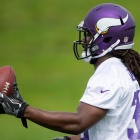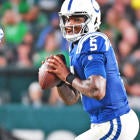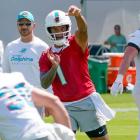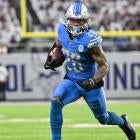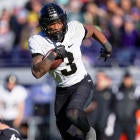Last year, despite averaging 20.4 attempts per game, the Vikings finished dead last in the NFL with 1,205 rush yards. It was the fewest since the Cardinals totaled 1,204 rush yards in 2012 -- but they barely tried that season (15.6 carries per game).
As you'd expect, the Vikings made moves to fix this problem. They signed offensive tackles Mike Remmers and Riley Reiff, and drafted Pat Elflein to try and fortify a horrid O-line. They also signed running back Latavius Murray in free agency, but the big-time move was trading up in the draft to take Florida State running back Dalvin Cook.
That's the guy we expect to lead the way for the Vikings.
From the draft-day trade to coach Mike Zimmer telling the media he "has a chance to be special," to Murray coming off of an ankle surgery that cost him practice time this spring, everything is lining up for Cook to handle the majority of touches in the Minnesota ground attack.
Let's take a gander at how Cook's rookie year might shake out.
To show how committed offensive coordinator Pat Shurmur was to the run in his nine games as play caller, he ordered 19.1 carries per week for his running backs, even though the talent wasn't great and the offensive line stunk. The work was split between Jerick McKinnon (10.1 carries, 3.9 catches per game) and Matt Asiata (6.6 carries, 1.9 catches per game). Other backs, including Adrian Peterson when he was healthy, chipped in for 4.7 carries per game.
Shurmur's tendencies have always favored running backs, including several times where he leaned on one back to handle the full workload. That includes Trent Richardson's 318-touch, 12-touchdown rookie outburst in Cleveland, by the way. All of this points to Cook getting the first crack to handle the majority of touches for the Vikings, mainly because he's explosive and healthy.
But Shurmur won't rush Cook into an every-down role. Instead, it seems likely he will begin the season splitting with Murray, who is a skilled pass protector and receiver. It would make sense for Murray to pick up passing downs work as well as short-yardage and goal-line carries given his size and power.
Until Cook proves otherwise, and he could during the season, that's a good assumption of the Vikings' plan.
Figure Cook picks up the carry averages of McKinnon and the Vikings' other running backs from the team's final nine games -- roughly 14.8 per game. Cook won't get McKinnon's 3.9 catches per game if Murray is working third downs, though. He'd probably be closer to the 1.9 average Asiata sported, which isn't too far off of the 2.1 receptions average he had in college.
That would put Cook in line for 237 carries and 30 catches -- only 21 rookie running backs have had more carries over the last 15 years.
Erase Cook's collegiate 6.5 rushing average from your mind. He won't get anywhere close to that in the NFL. The Vikings running backs could muster up only 3.2 yards per carry in '16, and had just six runs of 20-plus yards between them. Yuck! Cook is talented enough to improve those averages, but with the offensive line qualifying as no better than average, expectations should be held in check. Without trying to be too generous, let's assume he hits 4.1 yards per run -- among backs who had 100 carries last season, the average was 4.2.
While Cook averaged 14.8 yards per catch last year in college, the Vikings' backs pooled together to deliver a gross 6.9 receiving average. Cook and Murray will both help here, and Cook especially should come up with some big plays. He should be at least a full yard better than the Vikings' mediocre conglomerate was. We'll call it 7.9 yards per catch.
Based on his touch projections, it means Cook will go off for 972 rush yards and 237 receiving yards. That's 1,209 yards total.
It sounds great so far, right?
Here's where things can get messy.
The Vikings ran for nine touchdowns last year. That's it. Of the nine, eight were from five yards or closer.
Now we're sure the Vikings will run for more than nine touchdowns in 2017, and we're sure there will be more than just one from outside of five yards. Cook will contribute to that -- the average length of his touchdown runs last year was 20.2 yards. But the combination of an average offensive line and Murray hogging that goal-line job will hurt Cook's scoring production.
He'll probably swipe a few short-yardage touchdowns from Murray and have a few big-play scores of his own. Is six total touchdowns (one every 44.5 touches) asking for too much?
If you think so, don't draft Cook.
If you don't, then the projection is set.
This is just a shade higher than the projection I set for fellow rookie Joe Mixon. It's right on par with the numbers Todd Gurley posted last year, and would have put him on pace with the low-end No. 2 running backs from 2016, and about 16th overall among rushers in 2015.
However, Cook is going well past Mixon in drafts. FantasyPros.com lists Cook as the 21st running back off the board with a pick at 53rd overall on average in standard leagues (60th overall in PPR). Mixon, meanwhile, is going around 42nd overall as the 17th running back on average -- even earlier in PPR.
Given my projection, Cook is an absolute Fantasy Football bargain right now.















